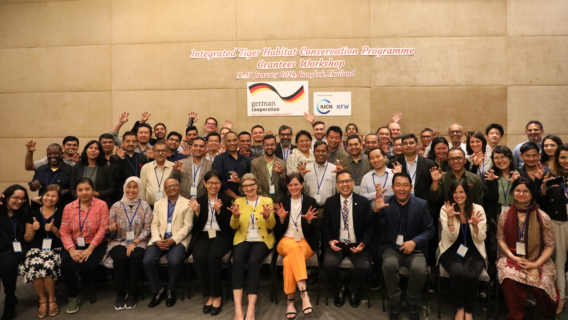
Dragonflies of Guainía: the search of Heteragrion demarmelsi
Project overview
Until recently, Guainía was one of Colombia’s departments with the fewest studies on Odonata. This has been changing progressively over the last decade, and Guainía is now recognized as one of the most diverse areas for these insects in Colombia. However, it has also become evident that its ecosystems and water bodies are threatened by the growing deforestation of the region, crop-associated burning practices, extensive livestock production, and a lack of clear public strategies for solid waste management.
Threats

Climate change

Habitat loss & degradation

Over-exploitation of natural resources & prey depletion
In the Cerros de Mavicure, one of Guainía’s main tourist sites, the flatwing damselfly Heteragrion demarmelsi—an Endangered species endemic to the Amazon region of Colombia—was recently reported. As Heteragrion species are known to inhabit well-preserved, oxygenated streams, this project aims to use this species, and odonates in general, as flagship species to promote the conservation of water bodies and forests in the area.
This project is presented as an effort to highlight and address the importance of insect conservation as a management strategy. It also seeks to empower the territory through community biomonitoring of dragonfly species and their habitats, which could serve as a foundation for strategic knowledge in the protection of water resources.
Project objectives
- Estimate the population dynamics of Heteragion demarmelsi in Mavicure, from capture-mark-recapture data, including the description of the overall dragonfly assemblage in the sampled localities.
- Implement the Dragonfly Biotic Index (DBI)* (Vorster et al 2019) for the distribution area of H. demarmelsi, in order to propose and establish the community biomonitoring protocol as a tool for its conservation and habitat protection.
*The Dragonfly Biotic Index (DBI), was earlier developed to assess the quality of South Africa’s freshwater ecosystems. This project would be the first approach of this tool for a Latin American country.
Project activities
- Conduct three field trips before, during, and after the rainy season. During these trips, an inventory of all dragonflies found will be made, with a high probability of finding new records for the country and new species for science.
- Implement a capture-mark-recapture methodology for the population analysis of the selected species, as well as the capture and marking of species that may be of interest in the areas where the project is being developed.
- Establish a community biomonitoring protocol for the registration, identification, and implementation of the DBI will be undertaken. A theoretical and practical workshop will be held during each field trip, complete with guides, identification materials, and evaluations of learning indicators at the end of each trip. The primary target population consists of community leaders and local tourist guides, who will be able to include the inventory and information on the natural history of dragonflies in their guides for local or foreign visitors.
This project is implemented by Yiselle Patricia Cano Cobos, Fundación Sociedad de Odonatlogía Latinoamericana and Universidad Nacional de Avellaneda.




